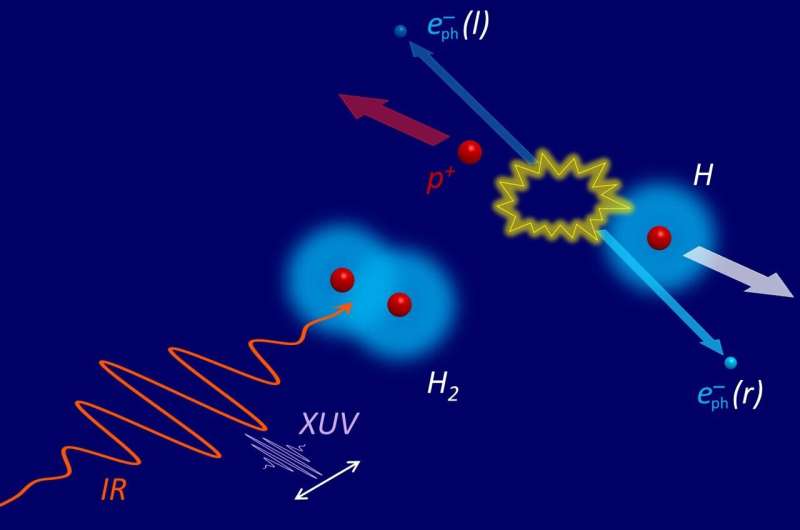
Sketch of the dissociative photoionization of molecular hydrogen using a combined IR and XUV laser pulse with a variable delay (white arrow). Credit: MPIK
Researchers at the Max Planck Institute for Nuclear Physics in Heidelberg have succeeded in selectively manipulating the movement of the electron pair in the hydrogen molecule.
The direction of emission of a photoelectron released by light (a photon) relative to the remaining bound electron in the cleaved neutral hydrogen atom can be controlled by the time interval between two laser flashes on the scale of a few hundred attoseconds (10⁻¹⁸ s) .
The adjustable emission asymmetry is based on the quantum entanglement between the bound electron and the spatially separated emitted electron.
Are we left or right? A fundamental question that has (usually) a simple answer on a walk through our classical world can be much more difficult to answer in the quantum world of elementary particles. Electrons and protons, the building blocks of molecules, can exist in states that simultaneously go left AND right, and they decide to “true” one of these choices the moment they are measured. (eg, by impact on a particle detector).
This phenomenon called quantum entanglement forms the basis of so-called quantum computers, where information is stored and processed in quantum bits (Qubits) that allow for superpositions of simultaneous ” right” AND “left”, or “0” AND “1” in computer lingo.
This makes quantum computation on such machines more powerful than classical computers, as multiple computations that would normally take time to run sequentially are now all running simultaneously.
But there are problems: Programming quantum computers is complex and requires many time-consuming steps—time during which the quantum processing unit can become unstable (through “decoherence”).
A team of physicists from MPIK Heidelberg—Farshad Shobeiry, Patrick Fross, Hemkumar Srinivas, Thomas Pfeifer, Robert Moshammer and Anne Harth (now Professor at Aalen University)—has taken a significant step toward a dramatic (>100,000-fold ) speed of the control of entangled quantum states, from nanoseconds to femto- (10⁻¹⁵ s) or even attoseconds (10⁻¹⁸ s).
The researchers studied the fundamental quantum dynamics of hydrogen molecules (two protons, two electrons) in their attosecond laser lab, capturing electrons and protons after their interaction with ultrashort flashes (pulses) of light. this. They found that the direction of emission of electrons with respect to protons can be changed by delaying the attosecond pulses with respect to the maxima and minima of a laser light wave on a time-scale of less than a femtosecond .
The work was published in the journal Scientific Reports.
A general theoretical model explains this discovery by the aforementioned superposition of states: Two electrons of the molecule are quantum-mechanically entangled even though they are in different locations (one of them flies separately, the one is still bound to a proton).
The theory also showed that these states, similar to the so-called Bell-states (a cornerstone of quantum information theory), can be changed by attosecond delays between high-frequency (extreme ultraviolet, XUV) and low -frequency (infrared, IR) light flash.
Although it is too early to design a viable quantum computer based on this idea, it provides fundamental insights into the physics for programming quantum information on very short time scales. The generality of the model used to explain the experiment carried out at MPIK Heidelberg allows, in principle, its translation from hydrogen to any other system where two colors of light can “mix” to achieve quantum control of entangled states on the fundamental “ultrafast” time scale of electronic motion.
More information:
Farshad Shobeiry et al, Controlling the emission of bound electrons in the photoionisation of a hydrogen molecule, Scientific Reports (2024). DOI: 10.1038/s41598-024-67465-0
Provided by the Max Planck Society
Quote: Physicists achieve ultrafast steering of quantum-entangled electrons (2024, September 12) retrieved on 12 September 2024 from https://phys.org/news/2024-09-physicists-ultrafast-quantum-entangled-electrons .html
This document is subject to copyright. Except for any fair dealing for the purpose of private study or research, no part may be reproduced without written permission. The content is provided for informational purposes only.
#Physicists #achieve #ultrafast #steering #quantumentangled #electrons